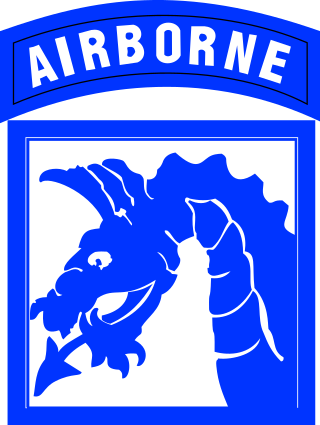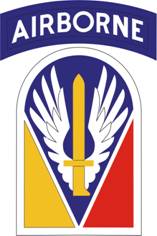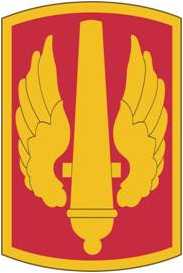
The 82nd Airborne Division is an airborne infantry division of the United States Army specializing in parachute assault operations into hostile areas with a U.S. Department of Defense mandate to be "on-call to fight any time, anywhere" at "the knife's edge of technology and readiness." Primarily based at Fort Liberty, North Carolina, the 82nd Airborne Division is part of the XVIII Airborne Corps. The 82nd Airborne Division is the U.S. Army's most strategically mobile division.

The XVIII Airborne Corps is a corps of the United States Army that has been in existence since 1942 and saw extensive service during World War II. The corps is designed for rapid deployment anywhere in the world and is referred to as "America's Contingency Corps." Its headquarters are at Fort Liberty, North Carolina.

III Corps is a corps of the United States Army headquartered at Fort Cavazos, Texas. It is a major formation of the United States Army Forces Command.

The United States Army Reserve (USAR) is a reserve force of the United States Army. Together, the Army Reserve and the Army National Guard constitute the Army element of the reserve components of the United States Armed Forces.
The Rapid Deployment Joint Task Force (RDJTF) is an inactive United States Department of Defense Joint Task Force. It was first envisioned as a three-division force in 1979 as the Rapid Deployment Force (RDF), a highly mobile rapid deployment force that could be rapidly moved to locations outside the normal overseas deployments in Europe and Korea. Its charter was expanded and greatly strengthened in 1980 as the RDJTF. It was inactivated in 1983, and re-organized as the United States Central Command (USCENTCOM).

Fort Johnson, formerly Fort Polk, is a United States Army installation located in Vernon Parish, Louisiana, about 10 miles (15 km) east of Leesville and 30 miles (50 km) north of DeRidder in Beauregard Parish.

The 325th Infantry Regiment is an infantry regiment of the 82nd Airborne Division. The regiment serves as the 82nd Airborne's light infantry parachute insertion fighting force of the United States Army, with a long and distinguished history, having taken part in World War I, World War II, the Vietnam War, the invasions of Grenada and Panama, as well as the Gulf and Iraq Wars. The subordinate units of the regiment constitute the bulk of the infantry elements assigned to the 2nd Infantry Brigade Combat Team, 82nd Airborne Division.

Carl Wade Stiner was a United States Army four-star general who served as Commander in Chief, United States Special Operations Command (USCINCSOC) from 1990 to 1993.

The United States Army Forces Command (FORSCOM) is the largest United States Army command. It provides expeditionary, regionally engaged, campaign-capable land forces to combatant commanders. Headquartered at Fort Liberty, North Carolina, FORSCOM consists of more than 750,000 active Army, U.S. Army Reserve, and Army National Guard soldiers. FORSCOM was created on 1 July 1973 from the former Continental Army Command (CONARC), who in turn supplanted Army Field Forces and Army Ground Forces.

The 45th Infantry Brigade Combat Team ("Thunderbird") is a modular infantry brigade combat team of the United States Army headquartered in Norman, Oklahoma. It is a part of the Oklahoma Army National Guard.

The reorganization plan of the United States Army was implemented from 2006 to 2016 under the direction of the Brigade Modernization Command. This effort formally began in 2006 when General Peter Schoomaker was given the support to move the Army from its Cold War divisional orientation to a full-spectrum capability with fully manned, equipped and trained brigades; this effort was completed by the end of 2016. It has been the most comprehensive reorganization since World War II and included modular combat brigades, support brigades, and command headquarters, as well as rebalancing the active and reserve components.

The 18th Field Artillery Brigade is the XVIII Airborne Corps field artillery brigade, based at Fort Liberty, North Carolina.

The structure of the United States Army is complex, and can be interpreted in several different ways: active/reserve, operational/administrative, and branches/functional areas.

The 2nd Chemical Battalion is a United States Army chemical unit stationed at Fort Cavazos, Texas, United States, and is part of the 48th Chemical Brigade. The battalion can trace its lineage from the 30th Engineer Regiment and has served in World War I, World War II, Korean War, Operation Desert Storm, and Operation Iraqi Freedom.

The 58th Infantry Regiment is a regiment of the United States Army first established in 1917.

The 172nd Infantry Regiment is a Vermont Army National Guard infantry regiment which specializes in mountainous and cold weather operations. It falls under the command of the Vermont Army National Guard's 86th Infantry Brigade Combat Team (Mountain). Before the creation of the Infantry Brigade Combat Team in 2008, the regiment was recognized as the only conventional unit in the United States Army trained and equipped for mountain operations. The regiment draws heritage from the original 10th Mountain Division, which fought during World War II, both in the type of training they conduct and in the specialized equipment the unit maintains.

The 525th Expeditionary Military Intelligence Brigade (Expeditionary) is a unit of the United States Army specializing in the acquisition and analysis of information with potential military value. On 28 October 2014, the unit was reflagged from the "525th Battlefield Surveillance Brigade" to an expeditionary military intelligence brigade, the first of its kind.

Willard McKenzie Burleson III is a United States Army lieutenant general who serves as the Commanding General of the Eighth United States Army and the Chief of Staff of the ROK/US Combined Forces Command.
















